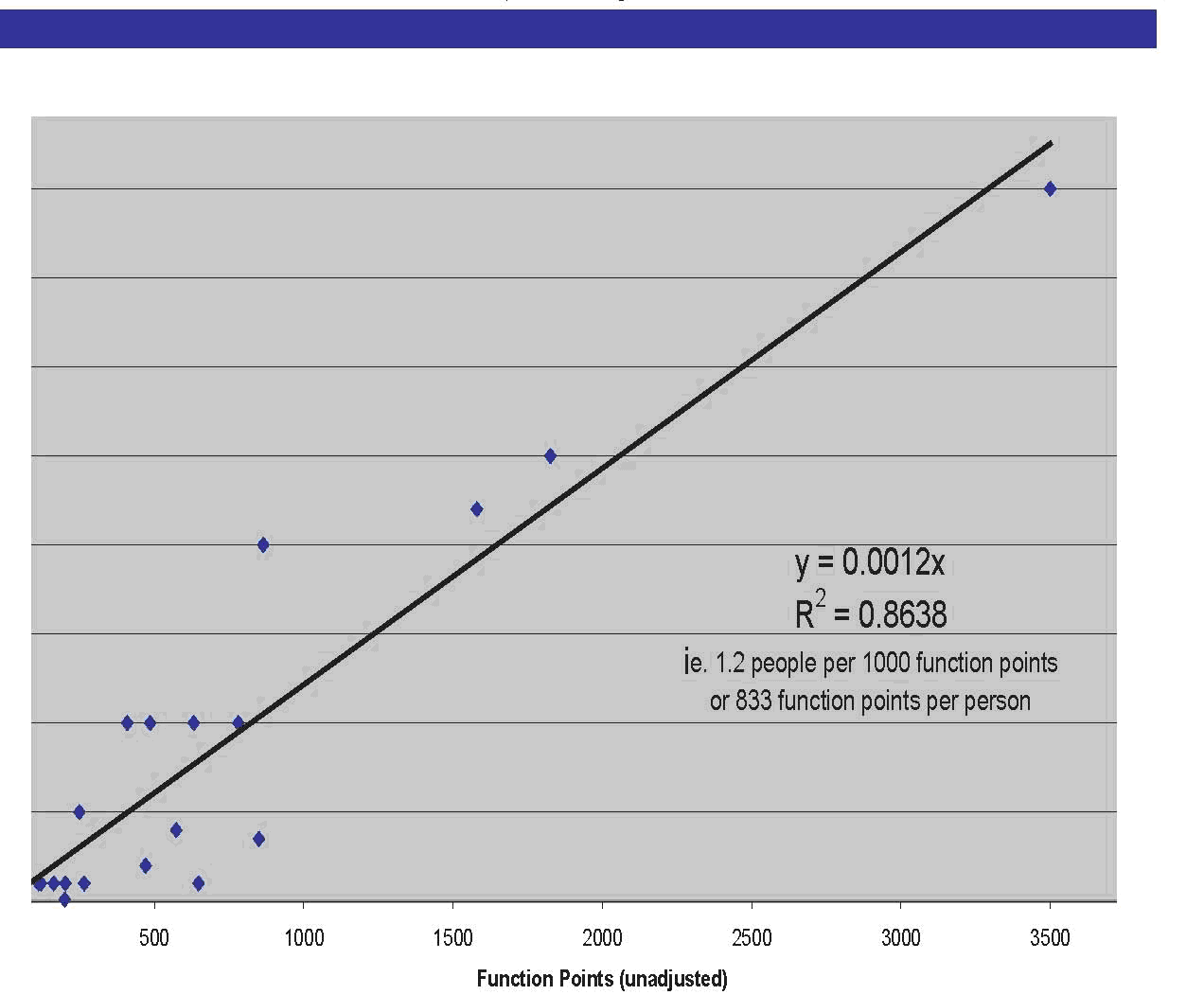
The number of personnel required to maintain and support an application is strongly related to the application’s size. Knowing the Functional Size of the application’s portfolio allows management to confidently budget for the deployment of support resources. The following figure demonstrates this relationship as demonstrated within an Australian financial organisation. The average maintenance assignment scope (number of function points supported per person) for this organisation is 833 function points per person. The assignment scope has been found to be negatively influenced by the age of the application and the number of users, i.e. as both these parameters increase the assignment scope decreases. 12Capers Jones figures show similar assignment scopes where for ageing, unstructured applications with high complexity an assignment scope of 500 function points per person is not unusual whereas newer, structured applications, skilled staff can support around 1500 – 2000 function

Figure 8-2 Relationship between the Size of an Application and the Number of Support staff (Source - Total Metrics 1999)
Once implemented, applications typically need constant enhancement in order to respond to changes in direction of an organisation’s business activities. Function points can be used to estimate the impact of these enhancements. The base function point count of the existing application will facilitate these estimates. As the application size grows with time the increasing assignment scope will provide the justification to assign more support staff.
The function point count of delivered functionality provides input into productivity and quality performance indicators. These can then be compared to those of other in-house development teams and implementation environments. Benchmarking internally and externally with industry data enables identification of best practice. External benchmarking data is readily available in the ISBSG Repository
(International Software Benchmarking Standards Group).
Project managers seeking ‘best practice’ in their software development and support areas recognise the need to adopt new tools, techniques and technologies to improve the productivity of the Process and quality of the products they produce. Baselining current practice enables management to establish current status and set realistic targets for improvement. Ongoing measurement of productivity and quality key performance indicators enable management to assess the impact of their implemented changes and identify where further improvements can be made. Function points are the most universally accepted method to measure the output from the software Process. They are a key metric within any Process improvement program because of their ability to normalise data from various software development environments combined with their ability to measure output from a business perspective as compared to a technical perspective.
The functional hierarchy of the functionality delivered by an application can also assist the support manager in planning and grouping change requests for each new release of the application. The hierarchy illustrates closely related functions and their relative size. If the impact of change is focused on a group of related functions then development effort will be reduced particularly in the design, testing and documentation stages of the project. This strategy of evaluating the scope of impact of a change request also reduces project risk by restricting projects to a manageable size and focusing change on a restricted set of related business functions.
Function Point Analysis is being used increasingly by organisations to support the ‘valuation of their software assets’. In the past, software has been considered an expense rather than a capital asset and as such was not included in an organisations asset register. The most commonly used software valuation method is based on the ‘deprival method’. This method values the software based on what it would cost to replace in today’s technical environment rather than what it cost originally to build. The industry build rate (dollar cost per function point) is determined and the total replacement value is calculated based on the current Functional Size of the application.
Since FPA provides a means of reliably measuring software, some organisations have implemented accrual budgeting and accounting in their business units. Under this directive, all assets must be valued based on deprival value and brought to account, thus ensuring better accountability of the organisations financial spending. Funding via budget allocation is based on assets listed in their financial accounts and their depreciation. In the past, the purchase price of the software recorded as an expense within an accounting year. These more recent accounting practices mean that it can now be valued as an asset and depreciated.
Publicly listed organisations have found that by using this accrual accounting method of measuring software as an asset rather than an expense they can amortise the depreciation over five years rather than artificially decrease the current year’s profit by the total cost of the software. This strategy has a dramatic effect on their share price since once their software is listed as a capital asset it contributes to the overall worth of the company and the total cost of that asset has a reduced impact on the current year’s reported profit.
The benefits of Functional size measurement in outsourcing contracts, is that Functional Size enables suppliers to measure the cost of a unit of output from the IT Process to the business and enables them to negotiate on agreed outcomes with their client.
Specifically these output based metrics based on function point analysis has enabled suppliers to:
Conversely these output based metrics based on function point analysis has enabled clients to:
Most of the international outsourcing companies use function point based metrics as part of their client service level agreements. Whilst this method of contract management is relatively new its proponents are strong supporters of the usefulness of the technique. In our experience once an outsourcing contract has been based on Function Point metrics subsequent contract renewals expand on their use.
Metrics initiatives have a high cost and need substantial investment, which is often overlooked at contract price negotiation. Both the supplier and the client typically incur costs. However, given the size of the penalties and bonuses associated with these contracts it soon becomes obvious that this investment is necessary.